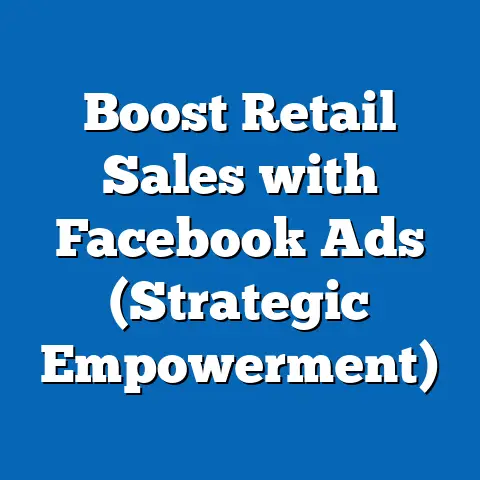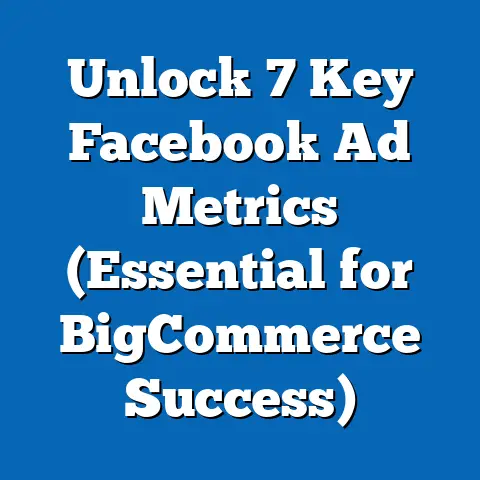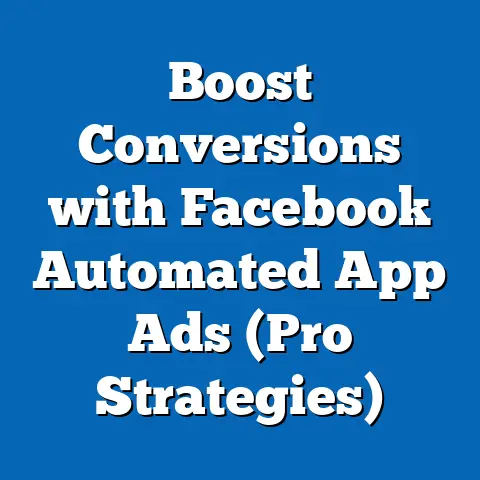Unleash Winning Facebook Ads Campaigns (Proven Strategies)
Facebook advertising is no longer an optional extra; it’s a cornerstone of modern digital marketing. With billions of active users, Facebook offers an unparalleled platform for businesses of all sizes to connect with their target audiences. I’ve seen firsthand how a well-executed Facebook ad campaign can transform a struggling business into a thriving one. But simply throwing money at ads isn’t enough. You need a strategic approach, and one of the most powerful strategies involves leveraging seasonal trends.
Think about it: consumer behavior shifts dramatically throughout the year. From the frenzy of Black Friday to the heartfelt sentiments of Valentine’s Day, different seasons evoke different emotions and needs. By understanding and tapping into these seasonal trends, you can craft Facebook ad campaigns that resonate deeply with your audience, leading to higher engagement, increased brand loyalty, and, ultimately, more sales.
For example, I once worked with a small, local bakery that was struggling to attract new customers. They had tried generic Facebook ads with little success. We decided to focus on the holiday season, creating a campaign featuring beautifully photographed images of their festive treats and offering limited-time discounts. The results were incredible! Their sales skyrocketed, and they gained a loyal following of customers who eagerly anticipated their seasonal offerings each year.
So, are you ready to unlock the full potential of Facebook advertising and transform your business with the power of seasonal trends? Let’s dive in!
Key Takeaways:
- Facebook advertising is crucial for reaching a vast and diverse audience.
- Leveraging seasonal trends can significantly enhance ad campaign performance.
- A strategic approach, combining creative design, targeted messaging, and effective budgeting, is essential for success.
- By understanding consumer behavior during different seasons, you can create ads that resonate deeply with your audience.
- This article provides actionable strategies and practical tips to help you create winning Facebook ad campaigns.
Section 1: Understanding Seasonal Trends in Advertising
To truly harness the power of seasonal advertising on Facebook, you need to understand the underlying principles that drive consumer behavior during different times of the year. It’s not just about slapping a Santa hat on your logo; it’s about understanding the psychology of seasonal shopping, identifying key events, and aligning your brand with the prevailing mood.
1.1 The Psychology of Seasonal Shopping
Seasonal shopping is deeply rooted in human psychology. It’s more than just a practical activity; it’s often an emotional experience. Different seasons evoke specific feelings and associations, which influence our purchasing decisions.
- Holidays (Christmas, Thanksgiving, Easter): These seasons are often associated with family, tradition, and generosity. Consumers are more likely to spend money on gifts, decorations, and festive food and beverages.
- Summer: Summer is often linked to freedom, relaxation, and outdoor activities. Consumers are more likely to purchase travel packages, outdoor gear, and summer clothing.
- Back-to-School: This season is associated with preparation, education, and new beginnings. Parents are more likely to spend money on school supplies, clothing, and electronics for their children.
- Valentine’s Day: This season is all about love, romance, and connection. Consumers are more likely to purchase gifts, flowers, and experiences for their partners.
Understanding these emotional drivers is crucial for crafting ad campaigns that resonate with your target audience. For example, an ad for a travel agency during the summer might focus on the feeling of escaping to a tropical paradise, while an ad for a department store during Christmas might emphasize the joy of giving and the importance of family traditions.
I remember working with a jewelry store that was struggling to generate sales outside of the holiday season. We decided to create a Valentine’s Day campaign that focused on the emotional connection between couples, rather than just the price of the jewelry. The ads featured heartwarming stories and images of couples expressing their love for each other. The campaign was a huge success, and the jewelry store saw a significant increase in sales and brand awareness.
Key Takeaways:
- Seasonal shopping is driven by emotional and psychological factors.
- Different seasons evoke specific feelings and associations.
- Understanding these emotional drivers is crucial for crafting effective ad campaigns.
- Focus on the emotional connection between your brand and your audience, rather than just the product or service you’re selling.
1.2 Identifying Key Seasonal Events
While major holidays like Christmas and Black Friday are obvious choices for seasonal campaigns, there are many other opportunities to leverage throughout the year. Identifying these lesser-known events can give you a competitive edge and help you reach a wider audience.
Here’s a list of some key seasonal events you can leverage:
- Major Holidays: Christmas, Thanksgiving, Easter, Halloween, Valentine’s Day, New Year’s Eve, Fourth of July, Labor Day, Memorial Day.
- Retail Events: Black Friday, Cyber Monday, Small Business Saturday, Back-to-School Sales, End-of-Season Sales.
- Cultural Events: St. Patrick’s Day, Cinco de Mayo, Chinese New Year, Diwali, Hanukkah.
- Environmental Events: Earth Day, Arbor Day, World Environment Day.
- Awareness Months: Breast Cancer Awareness Month (October), Black History Month (February), Pride Month (June).
- Sports Events: Super Bowl, Olympics, World Cup, March Madness.
- Other Events: Mother’s Day, Father’s Day, National Pet Day, International Women’s Day.
When choosing which events to target, consider your brand’s values, target audience, and product offerings. For example, a pet supply store might run a campaign for National Pet Day, while a health food store might focus on Earth Day.
I once worked with a sustainable clothing brand that wanted to increase its brand awareness and sales. We decided to create a campaign for Earth Day, highlighting the brand’s commitment to ethical and sustainable manufacturing practices. The ads featured images of the brand’s clothing being made in an eco-friendly factory, and the copy emphasized the importance of supporting sustainable businesses. The campaign resonated with environmentally conscious consumers, and the brand saw a significant increase in sales and brand awareness.
Key Takeaways:
- There are many seasonal events to leverage beyond major holidays.
- Identifying these lesser-known events can give you a competitive edge.
- Consider your brand’s values, target audience, and product offerings when choosing which events to target.
- Be creative and think outside the box to find unique opportunities to connect with your audience.
1.3 Aligning Your Brand with Seasonal Trends
Simply identifying seasonal events isn’t enough; you need to align your brand with the prevailing mood and messaging of each season. This involves adapting your ad copy, visuals, and product offerings to resonate with your target audience.
- Authenticity: Don’t try to force a connection that doesn’t exist. If your brand doesn’t naturally align with a particular season or event, it’s best to avoid it altogether.
- Relevance: Ensure your messaging is relevant to the season and your target audience. What are their needs and desires during this time of year? How can your product or service help them?
- Creativity: Don’t be afraid to get creative with your ad copy and visuals. Use seasonal imagery, colors, and themes to capture your audience’s attention.
- Value: Offer something of value to your audience, whether it’s a discount, a free gift, or helpful information.
For example, a coffee shop might offer a pumpkin spice latte during the fall, while a clothing store might feature cozy sweaters and jackets during the winter. It’s also important to adapt your messaging to the season. A coffee shop might use ad copy that emphasizes the warmth and comfort of their pumpkin spice latte, while a clothing store might focus on the practicality and style of their winter clothing.
I once worked with a technology company that wanted to create a holiday campaign. We decided to focus on the theme of giving back to the community, rather than just promoting the company’s products. The ads featured images of the company’s employees volunteering at local charities, and the copy emphasized the importance of supporting those in need. The campaign resonated with consumers who were looking for companies that shared their values, and the technology company saw a significant increase in brand loyalty and positive sentiment.
Key Takeaways:
- Aligning your brand with seasonal trends is crucial for connecting with your audience.
- Authenticity and relevance are key to successful seasonal campaigns.
- Be creative with your ad copy and visuals to capture your audience’s attention.
- Offer something of value to your audience to encourage engagement and conversions.
Section 2: Crafting Compelling Ads for Seasonal Campaigns
Now that you understand the importance of seasonal trends and how to align your brand with them, let’s dive into the specifics of crafting compelling Facebook ads that resonate with your target audience. This section will cover creative design and messaging, utilizing different ad formats, and developing effective call-to-action strategies.
2.1 Creative Design and Messaging
The visual elements of your ad are the first thing that catches the eye of potential customers. For seasonal campaigns, it’s crucial to use color schemes, imagery, and thematic messaging that evoke the feeling of the season.
- Color Schemes: Use colors that are associated with the season. For example, warm colors like red, orange, and yellow are often used for fall campaigns, while cool colors like blue and white are often used for winter campaigns.
- Imagery: Use images that are relevant to the season and your target audience. For example, an ad for a ski resort might feature images of people skiing down a snowy mountain, while an ad for a flower shop might feature images of roses and chocolates for Valentine’s Day.
- Thematic Messaging: Use messaging that aligns with the season and your brand’s values. For example, an ad for a charity might focus on the importance of giving back during the holiday season, while an ad for a travel agency might focus on the excitement of planning a summer vacation.
Storytelling is also a powerful tool for connecting with your audience on an emotional level. Share stories that resonate with the seasonal sentiments and values that your target audience holds dear.
I once worked with a local bookstore that wanted to create a holiday campaign. We decided to focus on the theme of “giving the gift of reading.” The ads featured images of people reading books by the fireplace, and the copy emphasized the importance of sharing the joy of reading with loved ones. The campaign resonated with book lovers, and the bookstore saw a significant increase in sales during the holiday season.
Key Takeaways:
- Use color schemes, imagery, and thematic messaging that evoke the feeling of the season.
- Tell stories that resonate with the seasonal sentiments and values of your target audience.
- Focus on creating ads that are visually appealing and emotionally engaging.
- Ensure your ads are consistent with your brand’s overall identity and messaging.
2.2 Utilizing Facebook Ad Formats
Facebook offers a variety of ad formats that can be used effectively for seasonal promotions. Each format has its own strengths and weaknesses, so it’s important to choose the right one for your campaign goals and target audience.
- Image Ads: These are the simplest and most common type of Facebook ad. They feature a single image or video, along with ad copy and a call-to-action button. Image ads are great for showcasing your product or service in a visually appealing way.
- Video Ads: Video ads are more engaging than image ads and can be used to tell a story or demonstrate how your product or service works. Video ads are particularly effective for seasonal campaigns, as they can evoke emotions and create a sense of connection with your audience.
- Carousel Ads: Carousel ads allow you to showcase multiple images or videos in a single ad. This format is great for highlighting different features of your product or service, or for telling a story in a sequential manner.
- Collection Ads: Collection ads are designed for mobile devices and allow users to browse and purchase products directly from the ad. This format is particularly effective for e-commerce businesses that want to drive sales during seasonal promotions.
- Slideshow Ads: Slideshow ads are similar to video ads, but they are created using a series of still images. This format is a great option for businesses that don’t have the resources to create a video ad.
For example, a clothing store might use a carousel ad to showcase its new winter collection, while a restaurant might use a video ad to promote its holiday menu.
I once worked with a travel agency that wanted to create a summer campaign. We decided to use a slideshow ad featuring images of people enjoying various summer activities, such as swimming, hiking, and relaxing on the beach. The ad copy emphasized the excitement of planning a summer vacation, and the call-to-action button directed users to the travel agency’s website, where they could book their trip. The campaign was a huge success, and the travel agency saw a significant increase in bookings during the summer months.
Key Takeaways:
- Facebook offers a variety of ad formats that can be used effectively for seasonal promotions.
- Choose the right ad format based on your campaign goals and target audience.
- Experiment with different ad formats to see what works best for your business.
- Use visually appealing images and videos to capture your audience’s attention.
2.3 Call-to-Action Strategies
The call-to-action (CTA) is the final element of your ad that encourages users to take the desired action. For seasonal campaigns, it’s crucial to create compelling CTAs that encourage immediate responses.
- Urgency: Use language that creates a sense of urgency, such as “Limited Time Offer,” “Sale Ends Soon,” or “Shop Now Before It’s Too Late.”
- Value: Highlight the value that users will receive by taking the desired action, such as “Get 20% Off,” “Free Shipping,” or “Download Our Free Guide.”
- Relevance: Ensure your CTA is relevant to the season and your target audience. For example, a CTA for a holiday campaign might be “Shop Now for Holiday Gifts,” while a CTA for a summer campaign might be “Book Your Summer Vacation Today.”
- Clarity: Make sure your CTA is clear and easy to understand. Use strong verbs that tell users exactly what you want them to do, such as “Shop,” “Book,” “Download,” or “Learn More.”
For example, a clothing store might use a CTA that says “Shop Our Winter Sale Now,” while a restaurant might use a CTA that says “Book Your Holiday Dinner Reservation Today.”
I once worked with an e-commerce business that wanted to increase sales during Black Friday. We decided to use a CTA that said “Shop Our Black Friday Sale Now and Get 50% Off All Items.” The ad also featured a countdown timer that showed how much time was left in the sale. The campaign was a huge success, and the e-commerce business saw a massive increase in sales during Black Friday.
Key Takeaways:
- Create compelling CTAs that encourage immediate responses from users.
- Use language that creates a sense of urgency and highlights the value of taking the desired action.
- Ensure your CTA is relevant to the season and your target audience.
- Make sure your CTA is clear and easy to understand.
Section 3: Targeting and Audience Segmentation
Crafting compelling ads is only half the battle. To truly maximize the effectiveness of your seasonal Facebook campaigns, you need to target the right audience. This section will cover defining your target audience, leveraging Facebook’s targeting tools, and implementing retargeting strategies for seasonal shoppers.
3.1 Defining Your Target Audience
Before you can start targeting your ads, you need to clearly define your target audience. This involves understanding their demographics, geographic location, and psychographics.
- Demographics: Consider factors such as age, gender, education level, income, and occupation.
- Geographic Location: Target users in specific cities, states, or countries.
- Psychographics: Understand your audience’s interests, values, lifestyle, and personality traits.
For example, a ski resort might target users who are between the ages of 25 and 55, live in major metropolitan areas, and are interested in skiing, snowboarding, and outdoor activities. A flower shop might target users who are between the ages of 25 and 45, live in the local area, and are interested in flowers, gifts, and romance.
I once worked with a local gym that wanted to create a New Year’s resolution campaign. We decided to target users who were between the ages of 25 and 45, lived in the local area, and were interested in fitness, health, and weight loss. We also targeted users who had expressed an interest in joining a gym or starting a new fitness routine in the past. The campaign was a huge success, and the gym saw a significant increase in new memberships during the month of January.
Key Takeaways:
- Clearly define your target audience before you start targeting your ads.
- Consider their demographics, geographic location, and psychographics.
- Use data and research to gain a deeper understanding of your target audience.
- Create buyer personas to represent your ideal customers.
3.2 Leveraging Facebook’s Targeting Tools
Facebook offers a wide range of targeting options that can help you reach the right audience for your seasonal campaigns.
- Custom Audiences: Create custom audiences based on your existing customer data, such as email lists, website visitors, and app users. This is a great way to target users who are already familiar with your brand.
- Lookalike Audiences: Create lookalike audiences based on your custom audiences. Facebook will identify users who share similar characteristics with your existing customers, allowing you to reach a wider audience that is likely to be interested in your product or service.
- Demographic Targeting: Target users based on their age, gender, education level, income, and other demographic factors.
- Interest Targeting: Target users based on their interests and hobbies.
- Behavior Targeting: Target users based on their online behavior, such as their purchase history, travel habits, and device usage.
For example, a clothing store might use custom audiences to target users who have previously purchased items from their website, while a restaurant might use lookalike audiences to reach new customers who are similar to their existing customers.
I once worked with a travel agency that wanted to create a summer campaign. We decided to use interest targeting to reach users who were interested in travel, vacations, and specific destinations. We also used behavior targeting to reach users who had recently searched for flights or hotels online. The campaign was a huge success, and the travel agency saw a significant increase in bookings during the summer months.
Key Takeaways:
- Facebook offers a wide range of targeting options that can help you reach the right audience.
- Use custom audiences to target users who are already familiar with your brand.
- Use lookalike audiences to reach new customers who are similar to your existing customers.
- Experiment with different targeting options to see what works best for your business.
3.3 Retargeting Strategies for Seasonal Shoppers
Retargeting is a powerful strategy for re-engaging users who have shown interest in your seasonal products but haven’t completed a purchase. This involves showing ads to users who have visited your website, viewed specific products, or added items to their shopping cart.
- Website Retargeting: Show ads to users who have visited your website.
- Product Retargeting: Show ads to users who have viewed specific products on your website.
- Cart Abandonment Retargeting: Show ads to users who have added items to their shopping cart but haven’t completed the purchase.
For example, a clothing store might show ads to users who have viewed their winter coat collection, while an e-commerce business might show ads to users who have added items to their shopping cart but haven’t completed the purchase.
I once worked with an e-commerce business that wanted to increase sales during Black Friday. We decided to use cart abandonment retargeting to show ads to users who had added items to their shopping cart but hadn’t completed the purchase. The ads featured a reminder of the items they had left in their cart, along with a discount code to encourage them to complete the purchase. The campaign was a huge success, and the e-commerce business saw a significant increase in sales during Black Friday.
Key Takeaways:
- Retargeting is a powerful strategy for re-engaging users who have shown interest in your products.
- Use website retargeting to show ads to users who have visited your website.
- Use product retargeting to show ads to users who have viewed specific products.
- Use cart abandonment retargeting to show ads to users who have added items to their shopping cart but haven’t completed the purchase.
Section 4: Budgeting and Bidding Strategies for Seasonal Campaigns
Effective budgeting and bidding strategies are essential for maximizing your ROI during seasonal campaigns. This section will cover setting a budget, choosing the right bidding strategy, and monitoring and adjusting your budget in real time.
4.1 Setting a Budget
Setting a budget for your seasonal campaigns involves considering factors such as your expected ROI and historical performance data from previous campaigns.
- Expected ROI: How much revenue do you expect to generate from your seasonal campaigns? Use this information to determine a budget that will allow you to achieve your goals.
- Historical Performance Data: Review the performance of your previous seasonal campaigns to identify what worked well and what didn’t. Use this information to inform your budget allocation for your current campaigns.
- Campaign Goals: What are your goals for your seasonal campaigns? Are you trying to increase brand awareness, generate leads, or drive sales? Your budget should align with your campaign goals.
- Competition: How competitive is the market during the season you are targeting? If the market is highly competitive, you may need to increase your budget to stand out from the crowd.
For example, if you expect to generate $10,000 in revenue from your holiday campaign, you might set a budget of $2,000, assuming a 5:1 return on ad spend (ROAS).
I once worked with a retail business that was unsure how to allocate their budget for their holiday campaign. We reviewed their historical performance data and identified that their previous holiday campaigns had generated a 4:1 ROAS. We also considered their campaign goals, which were to increase brand awareness and drive sales. Based on this information, we recommended a budget that was slightly higher than their previous holiday campaigns, but still within a reasonable range based on their expected ROI.
Key Takeaways:
- Consider your expected ROI and historical performance data when setting a budget for your seasonal campaigns.
- Align your budget with your campaign goals.
- Consider the level of competition in the market.
- Be realistic about your budget and don’t overspend.
4.2 Bidding Strategies
Facebook offers several different bidding strategies that you can use for your seasonal campaigns. The right bidding strategy will depend on your campaign goals and budget.
- Cost Per Click (CPC): You pay each time someone clicks on your ad. This strategy is best for driving traffic to your website.
- Cost Per Thousand Impressions (CPM): You pay for every 1,000 times your ad is shown. This strategy is best for increasing brand awareness.
- Cost Per Action (CPA): You pay each time someone takes a specific action, such as making a purchase or signing up for a newsletter. This strategy is best for driving conversions.
- Value Optimization: Facebook automatically optimizes your bids to maximize the value of your conversions. This strategy is best for e-commerce businesses that want to increase sales.
- Lowest Cost: Facebook automatically bids to get you the lowest possible cost per result. This strategy is best for businesses that are on a tight budget.
For example, if you are trying to drive traffic to your website, you might choose the CPC bidding strategy. If you are trying to increase brand awareness, you might choose the CPM bidding strategy.
I once worked with an e-commerce business that wanted to increase sales during Black Friday. We decided to use the value optimization bidding strategy, as this strategy is designed to maximize the value of conversions. We also set a target ROAS, which told Facebook how much revenue we wanted to generate for every dollar we spent. The campaign was a huge success, and the e-commerce business saw a massive increase in sales during Black Friday.
Key Takeaways:
- Choose the right bidding strategy based on your campaign goals and budget.
- CPC is best for driving traffic to your website.
- CPM is best for increasing brand awareness.
- CPA is best for driving conversions.
- Value optimization is best for e-commerce businesses that want to increase sales.
4.3 Monitoring and Adjusting Your Budget
Monitoring your campaign performance in real time is essential for maximizing ad spend efficiency. This involves tracking key metrics such as click-through rates, conversion rates, and return on ad spend.
- Click-Through Rate (CTR): The percentage of users who click on your ad after seeing it.
- Conversion Rate: The percentage of users who take the desired action after clicking on your ad.
- Return on Ad Spend (ROAS): The amount of revenue you generate for every dollar you spend on advertising.
- Cost Per Acquisition (CPA): The cost of acquiring a new customer through your advertising campaigns.
If you notice that your CTR is low, you may need to adjust your ad copy or visuals. If you notice that your conversion rate is low, you may need to improve your landing page or offer a better incentive. If you notice that your ROAS is low, you may need to adjust your bidding strategy or target a different audience.
For example, if you notice that your CTR is low for your winter clothing ad, you might try using a different image or writing more compelling ad copy. If you notice that your conversion rate is low for your holiday dinner reservation ad, you might try offering a discount or adding more social proof to your landing page.
I once worked with a restaurant that was running a holiday campaign. We were monitoring their campaign performance in real time and noticed that their CTR was low. We decided to adjust their ad copy and visuals, and we saw a significant increase in their CTR. We also noticed that their conversion rate was low, so we decided to improve their landing page and offer a discount to users who booked a holiday dinner reservation. These changes helped them to significantly improve their campaign performance and achieve their goals.
Key Takeaways:
- Monitor your campaign performance in real time to identify areas for improvement.
- Track key metrics such as click-through rates, conversion rates, and return on ad spend.
- Adjust your ad copy, visuals, bidding strategy, or targeting based on your campaign performance.
- Be prepared to make adjustments to your budget as needed.
Section 5: Analyzing and Optimizing Campaign Performance
Analyzing and optimizing your campaign performance is an ongoing process. This section will cover defining key performance indicators (KPIs), using A/B testing to experiment with different elements of your ads, and conducting a thorough post-campaign analysis to identify successes and areas for improvement.
5.1 Key Performance Indicators (KPIs)
Key Performance Indicators (KPIs) are the metrics you will use to measure the success of your seasonal Facebook ad campaigns. It’s crucial to define these KPIs before you launch your campaign so you can track your progress and make necessary adjustments along the way.
- Reach: The number of unique users who saw your ad.
- Impressions: The number of times your ad was displayed.
- Click-Through Rate (CTR): The percentage of users who clicked on your ad after seeing it.
- Conversion Rate: The percentage of users who took the desired action after clicking on your ad.
- Cost Per Acquisition (CPA): The cost of acquiring a new customer through your advertising campaigns.
- Return on Ad Spend (ROAS): The amount of revenue you generate for every dollar you spend on advertising.
- Engagement Rate: The percentage of users who interacted with your ad (e.g., likes, comments, shares).
For example, if your goal is to increase brand awareness, you might focus on reach, impressions, and engagement rate. If your goal is to drive sales, you might focus on conversion rate, CPA, and ROAS.
I once worked with a local business that was running a holiday campaign. We helped them to define their KPIs before they launched their campaign, and we tracked their progress on a weekly basis. This allowed them to make necessary adjustments to their campaign and achieve their goals.
Key Takeaways:
- Define your KPIs before you launch your campaign.
- Track your progress on a regular basis.
- Use your KPIs to measure the success of your campaign.
- Adjust your campaign as needed based on your KPIs.
5.2 A/B Testing and Experimentation
A/B testing is a powerful technique for optimizing your ad performance. This involves creating two or more versions of your ad with slight variations and then testing them against each other to see which one performs better.
- Headlines: Test different headlines to see which one captures your audience’s attention the most.
- Images: Test different images to see which one is the most visually appealing.
- Ad Copy: Test different ad copy to see which one is the most persuasive.
- Call-to-Action Buttons: Test different call-to-action buttons to see which one encourages the most users to take the desired action.
- Targeting Options: Test different targeting options to see which one reaches the most relevant audience.
For example, you might create two versions of your ad with different headlines and then test them against each other to see which one has a higher CTR. You might also create two versions of your ad with different images and then test them against each other to see which one has a higher conversion rate.
I once worked with an e-commerce business that was running a Black Friday campaign. We used A/B testing to experiment with different headlines, images, and call-to-action buttons. This helped us to identify the most effective elements of their ads and significantly improve their campaign performance.
Key Takeaways:
- A/B testing is a powerful technique for optimizing your ad performance.
- Test different headlines, images, ad copy, call-to-action buttons, and targeting options.
- Use the results of your A/B tests to make informed decisions about your ad campaigns.
- Continuously experiment with different elements of your ads to see what works best.
5.3 Post-Campaign Analysis
Conducting a thorough analysis after your campaign ends is crucial for identifying successes and areas for improvement. This involves reviewing your campaign data, identifying what worked well and what didn’t, and documenting your findings for future seasonal campaigns.
- Review Campaign Data: Review your campaign data to identify key trends and patterns.
- Identify Successes: Identify what worked well during your campaign. What headlines, images, ad copy, and targeting options were the most effective?
- Identify Areas for Improvement: Identify what didn’t work well during your campaign. What headlines, images, ad copy, and targeting options were the least effective?
- Document Findings: Document your findings for future seasonal campaigns. This will help you to avoid making the same mistakes in the future and to build on your successes.
For example, you might find that your ads with images of people smiling performed better than your ads with product images. You might also find that your ads targeting users who were interested in a specific hobby performed better than your ads targeting a broader audience.
I once worked with a travel agency that was running a summer campaign. After the campaign ended, we conducted a thorough analysis of their campaign data. We identified that their ads with images of people relaxing on the beach performed better than their ads with images of famous landmarks. We also found that their ads targeting users who were interested in specific destinations performed better than their ads targeting a broader audience. We documented these findings for future summer campaigns, which helped them to significantly improve their campaign performance.
Key Takeaways:
- Conduct a thorough analysis after your campaign ends.
- Review your campaign data to identify key trends and patterns.
- Identify what worked well and what didn’t.
- Document your findings for future seasonal campaigns.
Conclusion
Leveraging seasonal trends in your Facebook ad campaigns is a powerful strategy for increasing engagement, brand loyalty, and sales. By understanding the psychology of seasonal shopping, crafting compelling ads, targeting the right audience, and optimizing your campaign performance, you can unlock the full potential of Facebook advertising and transform your business.
Remember to:
- Understand the Psychology of Seasonal Shopping: Different seasons evoke different emotions and needs. Craft your ads to resonate with these feelings.
- Craft Compelling Ads: Use seasonal color schemes, imagery, and thematic messaging. Tell stories that connect with your audience on an emotional level.
- Target the Right Audience: Clearly define your target audience and use Facebook’s targeting tools to reach them effectively.
- Budget Wisely and Bid Strategically: Set a budget that aligns with your campaign goals and choose the right bidding strategy to maximize your ROI.
- Analyze and Optimize: Continuously monitor your campaign performance and make necessary adjustments to improve your results.
I’ve seen firsthand how these strategies can transform a business, and I encourage you to implement them in your upcoming advertising efforts. Don’t be afraid to experiment, learn from your mistakes, and continuously improve your approach.
Now, it’s time to take action! Start planning your next seasonal Facebook ad campaign today and unlock the power of seasonal trends to drive your business to new heights.
Call to Action:
Start planning your next seasonal Facebook ad campaign today! Download our free guide to seasonal advertising for more tips and strategies. [Link to Free Guide]






